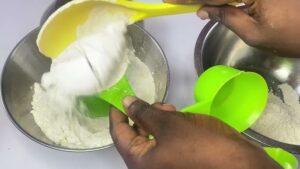If you’re a baker, chef, or just someone who loves spending time in the kitchen, you’ve likely asked: How many cups of flour are in a 10 kg bag? Whether you’re prepping for a big baking project or stocking up your pantry, knowing how to convert weight to volume is super helpful. This guide will walk you through everything you need to know clear, simple, and no confusing math required!
How Many Cups of Flour in a 10 Kg Bag gives you around 80 cups. That’s based on the common estimate that 1 cup of flour weighs about 125 grams.”
Understanding the Basics: Weight vs. Volume
Before diving into conversions, it’s important to know the difference between weight (kilograms) and volume (cups):
- Weight: Measures how heavy something is (e.g., 10 kg of flour).
- Volume: Measures how much space it takes up (e.g., 1 cup of flour).
Different ingredients weigh different amounts per cup, so conversion varies based on the ingredient and how it’s measured.
The Key Conversion: 10 Kg of Flour to Cups
Let’s get to the heart of the question.
- 1 cup of all-purpose flour weighs approximately 120 grams.
- 10 kilograms = 10,000 grams.
➤ So, how many cups of flour are in 10 kg?
- 10,000 grams ÷ 120 grams per cup = approximately 83.33 cups
- ✅ Answer: A 10 kg bag of all-purpose flour contains around 83 cups.
Things That Can Affect This Measurement
While the basic math gives us a solid estimate, a few factors can slightly change the outcome:
How Many Cups of Flour in a 10 Kg Bag? Get Answers!
1. Flour Type Matters
- All-purpose flour: ~120g per cup
- Bread flour: ~130g per cup
- Cake flour: ~100g per cup
- Whole wheat flour: ~130g per cup
2. How You Scoop
- Scoop and sweep method packs more flour.
- Fluff and spoon method gives a lighter, more accurate cup.
- Always level with a knife for consistency.
3. Humidity
- In humid environments, flour can absorb moisture and weigh more per cup.
Quick Reference Table: Flour Conversions
| Flour Type | Grams per Cup | Cups in 10kg |
|---|---|---|
| All-purpose | 120g | ~83 cups |
| Bread Flour | 130g | ~77 cups |
| Cake Flour | 100g | ~100 cups |
| Whole Wheat Flour | 130g | ~77 cups |
📌 Tip: Always check the packaging for specific weight info if available.
Why This Conversion Is Helpful
Knowing how many cups are in a 10 kg bag can help with:
- Meal planning: Figure out how long a bag of flour will last.
- Batch cooking: Great for bakeries, restaurants, or large family events.
- Shopping smarter: Compare costs based on usable quantity.
Common Questions People Ask
🥖 How many cookies can I make with 10 kg of flour?
It depends on the recipe, but a standard chocolate chip cookie recipe uses about 2.5 cups of flour for 24 cookies. With 83 cups:
- 83 ÷ 2.5 = approx. 33 batches → 800+ cookies!
🍞 How much bread can I bake?
A loaf of bread typically uses 3 to 4 cups of flour. That means:
- 83 ÷ 3.5 = about 23–27 loaves of bread
Tips for Measuring Flour Accurately
- Use a kitchen scale for precise results—especially in baking.
- Avoid scooping directly from the bag; instead, spoon flour into your cup.
- Fluff up the flour before measuring to avoid compacting it.
- Level off the top of the cup using a flat edge.
Real-Life Example: Bakery Planning
Imagine you run a small bakery and want to make your signature muffins. Each batch uses 4 cups of flour and makes 12 muffins.
- With 83 cups of flour, you could make:
- 83 ÷ 4 = 20 batches → 240 muffins
That helps with budgeting and prep work—especially if you’re scaling up for a market or event.
Visual Tip: Add a Conversion Chart (Recommended Image)
Create or insert a simple infographic that shows:
- Kilograms to cups for various flour types
- Weight per cup
- Tips for scooping methods
Alt Text Suggestion: “Conversion chart showing how many cups of different types of flour are in 10 kilograms.”
Conclusion: Make Every Cup Count
Now you know that a 10 kg bag of flour contains about 83 cups of all-purpose flour. Whether you’re baking cookies, bread, or planning for bulk needs, this knowledge makes your kitchen prep a breeze.
✅ Key Takeaway: One 10 kg flour bag = ~83 cups (for all-purpose flour)
So next time you’re in the grocery store or mixing dough at home, you’ll know exactly what to expect from your bag of flour. Happy baking!


